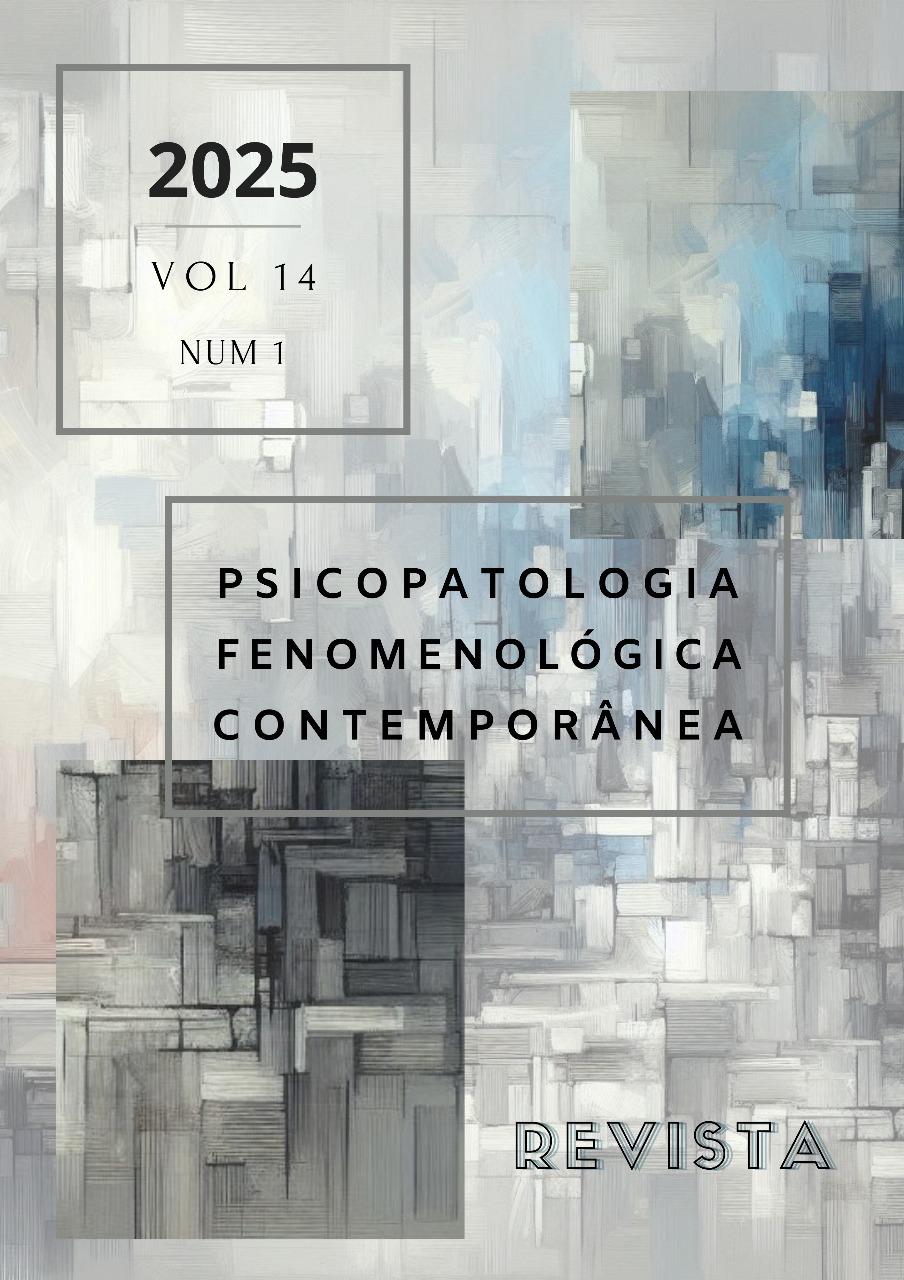A phenomenological-temporal perspective on inattention and hyperactivity
arrhythmia and desynchronization
DOI:
https://doi.org/10.37067/rpfc.v14i1.1226Palavras-chave:
Phenomenology, Temporality, Attention deficit disorder with hyperactivity, Inattention, HyperactivityResumo
The present work deals with a phenomenological analysis of the condition that contemporary psychiatry classifies as Attention Deficit Hyperactivity Disorder (ADHD). Our investigation was primarily based on understanding what would properly characterize the world experience in question for the phenomena of inattention and hyperactivity. Such experience is marked by a particular and predominantly dissonant rhythm in relation to the temporality of the most direct everyday demands, thus we argue that a desynchronization between the patient's subjective temporality and the temporal processes of their environment, based on the fact that the relationship with time is determinant in human experience, would be at the base of the phenomena of inattention and hyperactivity. Finally, we also propose a reflection on how the current socio-historical circumstances and their regimes of temporalization accentuate and demarcate this phenomenon in a particular way.
Downloads
Métricas
Referências
Adan-Manes, J., & Ramos-Gorostiza, P. (2014). Should Definitions for Mental Disorders Include Explicit Theoretical Elements? In Psychopathology, 47(3), 158-166.
American Psychiatric Association. (2022). Manual diagnóstico e estatístico de transtornos mentais: DSM-5-TR (5ª ed., texto rev.). Porto Alegre: Artmed.
American Psychiatric Association. (2022). Diagnostic and statistical manual of mental disorders: DSM-5-TR (5th ed., text rev.). Washington, DC: American Psychiatric Association Publishing.
Andreasen, N. C. (2006). DSM and the Death of Phenomenology in America: An Example of Unintended Consequences. In Schizophrenia Bulletin, 33(1), 108–112.
Barkley, R. A. (2022). Taking charge of adult ADHD: Proven strategies to succeed at work, at home, and in relationships (2nd ed.). New York: The Guilford Press.
Barkley, R. A., & Fischer, M. (2010). The Unique Contribution of Emotional Impulsiveness to Impairment in Major Life Activities in Hyperactive Children as Adults. Adolescent Psychiatry, 49(5).
Brown, T. E. (2013). A New Understanding of ADHD In Children and Adults: Executive Function Impairments. New York: Routledge.
Canguilhem, G. (2007). O normal e o patológico (6a ed. rev.). Rio de Janeiro: Forense Universitária.
Ehrenberg, A. (1998). La fatigue d’être soi – Dépression et Société. Paris: Odile Jacob.
Faraone, S. V. et al. (2019). Practitioner Review: Emotional dysregulation in attention-deficit/hyperactivity disorder - implications for clinical recognition and intervention. Journal of Child Psychology and Psychiatry, 60(2), 133–150.
Fuchs, T. (2001). Die Zeitlichkeit des Leidens. In Phänomenologische Forschungen. Hamburg: Felix Meiner Verlag.
Fuchs, T. (2010). Temporality and psychopathology. Phenomenology and the Cognitive Sciences, 12(1), 75–104.
Fuchs, T. (2015). Zeiterfahrung in Gesundheit und Krankheit. In Psychotherapeut, 60. Heidelberg/München: Springer.
Fuchs, T. (2016) Intercorporeality and Interaffectivity. In Phenomenology and Mind, n. 11, 194-209. Firenze University Press
Fuchs, T. (2018). Chronopathologie der Überforderung: Zeitstrukturen und Psychischer Krankheit. In Das Überforderte Subjekt: Zeitdiagnosen einer Beschleunigten Gesellschaft. Berlin: Suhrkamp.
Fuchs, T. (2020) Verkörperte Emotionen und ihre Regulation. In Handbuch Emotionsregulation. Springer-Verlag, Berlin, p. 20-28.
Fuchs, T. (2022) Der Schein des Anderen: Empathie und Virtualität. In: Verteidigung des Menschen: Grundfragen einer verkörperten Anthropologie. Suhrkamp, Berlin, p. 119-146
Han, B. (2015). A sociedade do cansaço (2 ed.). Petrópolis/RJ: Vozes.
Heidegger, M. (2009). Ser y tiempo (2 ed.). Madrid: Trotta.
Husserl, Edmund. (1964) The Phenomenology of Internal Time-Consciousness. Indiana University Press
Lantéri-Laura, G. (2000). Ensayo sobre los paradigmas de la psiquiatría moderna. Madrid: Editorial Triacastela.
Lefebvre, H. (2004). Rhythmanalysis: Space, Time and Everyday Life. London and New York: Continuum.
Lezak, M. D. (2012). Neuropsychological assessment (5th ed.). New York: Oxford University Press.
Mattar, C. (2021). Depressão: Doença Ou Fenômeno Epocal. Rio de Janeiro/RJ: Via Verita.
Marmorato, P. G. (2012). A hiperatividade no tempo de Minkowski. Revista Psicopatologia Fenomenológica Contemporânea, 1(1), 124–134.
Marmorato, P. G. (2022). Hipercinesia, desatenção e os transtornos do comportamento disruptivo. In Fundamentos da Clínica Fenomenológica, 289-305. São Paulo, Manole Editora.
Martinez-Badía, J. (2015). Who says this is a modern disorder? The early history of attention deficit hyperactivity disorder. World Journal of Psychiatry, 5(4), 379.
Messas, G., & Fukuda, L. (2018). O diagnóstico psicopatológico fenomenológico da perspectiva dialético-essencialista. Revista Pesquisa Qualitativa, 6(11), 160.
Merleau-Ponty, Maurice. (2013) Phenomenology of Perception. Abingdon (UK), Routledge.
Minkowski, E. (1995). Le Temps Vécu. Paris: Presses Universitaires de France.
Nielsen, M. (2017). ADHD and Temporality: A Desynchronized Way of Being in the World. Medical Anthropology, 36(3), 260–272.
Nietzsche, F. (2011). A gaia ciência. São Paulo/SP: Companhia das Letras.
Parnas, J., & Zahavi, D. (2002). The Role of Phenomenology in Psychiatric Diagnosis and Classification. Em: Maj, M. et al. (Eds.), Psychiatric Diagnosis and Classification (pp. 137–162). Chichester, UK: John Wiley & Sons, Ltd.
Rosa, H., & Trejo-Mathys, J. (2013). Social acceleration: A new theory of modernity. New York: Columbia University Press.
Verhoeff, B. (2010). Normaal of pathologisch? De visie van arts em filosoof Georges Canguilhem. In Tijdschrift voor Psychiatrie, 52, 639-647
Downloads
Publicado
Edição
Seção
Licença
Copyright (c) 2025 Daniel Victor Barbosa Magalhaes, Mathias Waldburger, Gabriel Becher, André Sendra de Assis

Este trabalho está licenciado sob uma licença Creative Commons Attribution-NonCommercial 4.0 International License.
Os autores detém os direitos autorais sem restrições, devendo informar a publicação inicial nesta revista, em caso de nova publicação de algum trabalho.









